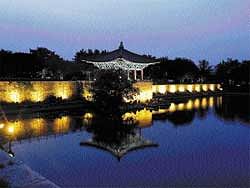
Stored in a glass cubicle, this precious relic belonged to the Silla dynasty emperors who ruled undivided Korea for almost a millennium since 57 BC. Recognised as a national treasure, the coronet was excavated from a tomb in Gyeongju, which was then the capital of Silla emperors. Located 280 km away from Seoul, tourists in large numbers storm there today to see the legacy of a period that has been termed as the golden era of the north Asian nation. I come across many more Silla-period exhibits that testify the glories of the famous dynasty, but more importantly, prepare me well with information for my subsequent visit to Gyeongju, the 2,000- year-old city of great historical significance.
Historians credit the Silla empire for establishing a unified Korea. Prior to their time, the peninsula comprised three separate kingdoms. When Julius Caesar was subduing Gaol, Silla King Munmu established Gyeongju as the capital city which over time became the ‘City of Gold’. Aristocracy there pursued high culture and extravagant lifestyles. Writings from early visitors reveal that elite government officials had thousands of human slaves plus almost an equal number of horses, cattle and pigs. Their wives wore solid gold tiaras and ear-rings of intricate and delicate filigree. Buddhism, which earlier migrated from China, gained the status of a state religion.
Gyeongju today is a contemporary city with no shortage of facilities to indulge modern day visitors, including plush accommodation and upmarket restaurants. However, compared to the nation’s capital, this metropolis of 3,50,000 people is quieter, slow paced and engulfed with tranquillity. Entering its quarters, I realise almost immediately why this treasure trove is often referred to as ‘museum without walls’. Gyeongju holds more tombs, temples, rock carvings, pagodas, Buddhist statuaries and palace ruins than any other place in Korea. This grand historic ensemble pledges to mesmerise every visitor that walks along its paths, making history as their companion.
The city’s National Museum is a good starting point to begin Gyeongju sojourn as it’s recognised as a vault of Silla heritage. Galleries are packed with artefacts — sculptures, potteries, jewellery and royal memorabilia — that help draw some pictures of a highly cultured and wealthy period. However, the exhibit that’s always surrounded by people is a four metre high, 19 ton bronze bell, which was cast in the late 8th century. Known as Emily Bell, it’s Asia’s largest and most resonant. It’s said that its jingles could be heard 40 miles away. The inscriptions on the bell are a fine example of Asian calligraphy and carving. Most of the museum’s treasures were excavated from the royal tombs, large earthen mounds that looked like grass-covered hillocks from a distance.
Two of the city’s must-see sites are the Bulguksa Temple and the Seokguram Grotto, both UNESCO World Heritage sites that proudly testify the grandness of Silla architecture.
Nestled among knobby pines and iris gardens that would enthuse artists like Monet and Manet, Bulguska Temple is not a single edifice, but a sprawling complex comprising well preserved pagodas, prayer halls, large terraces dotted with artefacts and temples with Buddha statues inside. A significant feature of the shrine are several stone bridges.
However, the one with 33 steps is highly revered as it represents 33 stages to achieve enlightenment, a Buddhist belief. Crafted in traditional Korean style of the time, all the ancient monuments reflect the extraordinary carpentry and painting skills of the workers.
However, the octagonal Dabotop pagoda standing on a cruciform base with stairways on all four sides and the three storied, highly ornamental Seokgatap pagoda draws most attention. Some of the wooden panels have carvings of the Om symbol, signifying the link of Buddhism with ancient Hindu philosophy.
Overlooking the Sea of Japan, the Seokguram Grotto nests a little distance away from Bulguksa Temple on Mt Tohamsan, a holy mountain to the Silla kingdom. This cave is so important and fragile that visitors are allowed only a brief glimpse of the interior and photography is prohibited. The architecture is similar to other rock-carved cave temples in China and India, but stones of Korea being unsuitable for carving, this grotto is
artificially made of hundreds of granite stones, held together by stone rivets and no mortar.
The layout of the granite sanctuary consists of a rectangular ante-chamber and a round rotunda hall, the centrepiece of which is a three-and-a-half-metre high Buddha statue, sitting on a lotus pedestal with a serene expression of meditation. Figures of several bodhisattvas and colourful guardians surround the main statue. A common
ritual at the site is to write religious messages on stone slabs.
The profligate lifestyle of Silla kings is evident when visiting the exotic Anapji Pond, an artificial lake with three islands and modelled mountain peaks which was earlier annexed to a palace. Only a small portion still remains to justify the sumptuousness of the past.
This site is close to the 7th century bottle-shaped Cheomseongdae observatory, admired worldwide by archaeologists for its engineering feat. After the fall of Silla dynasty, the prosperity of Gyengju began declining and today it quietly remains as a library of Korea’s rich historical past.